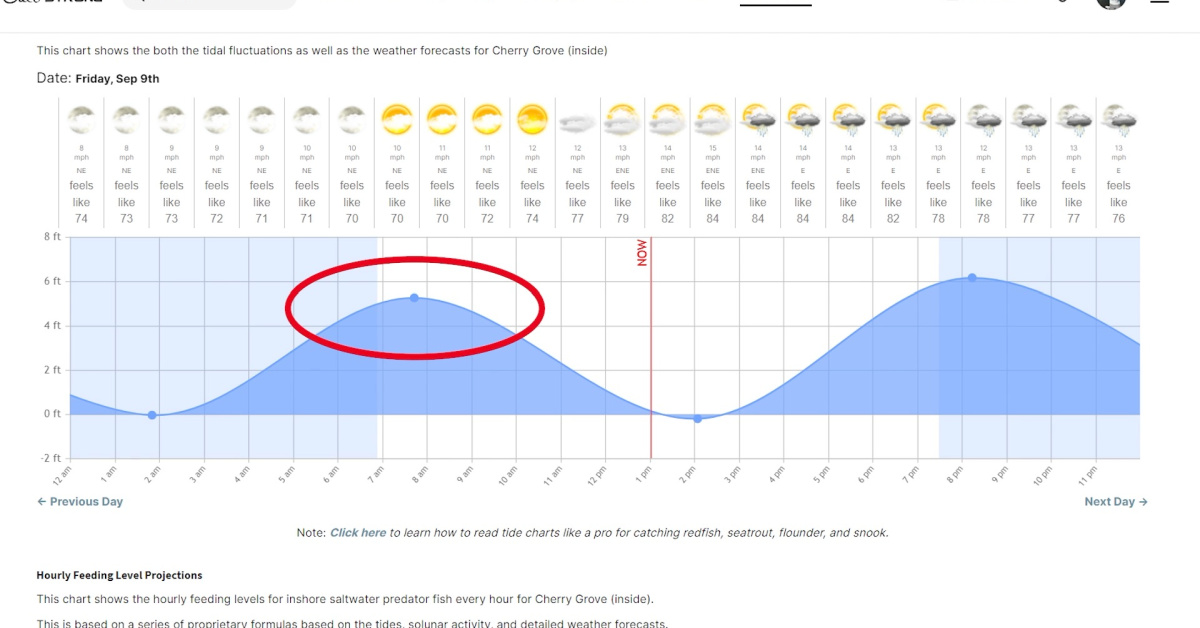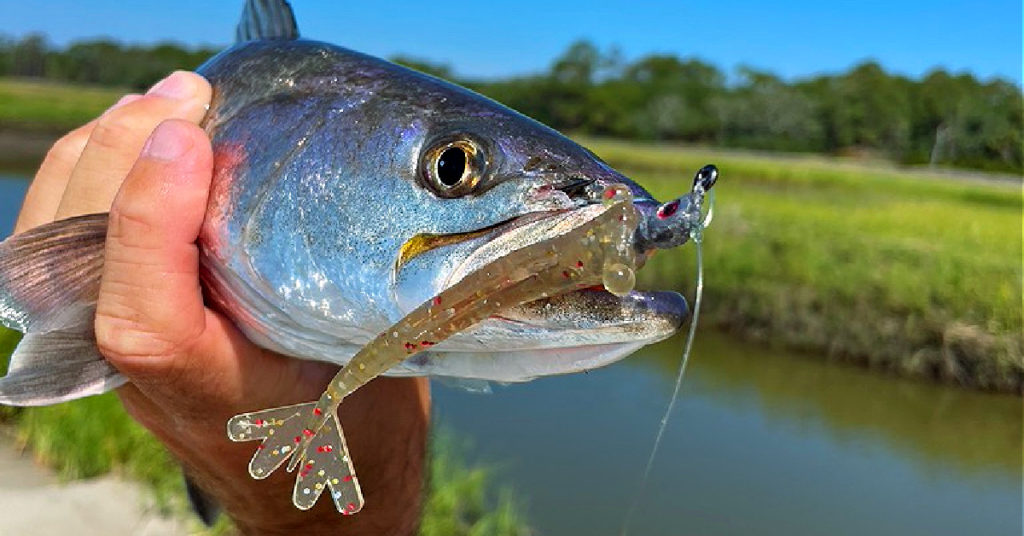How To Fish In Areas With Big Tide Swings
- By: Pat Ogletree
- on

How should you fish a big tide swing?
What are the indicators of a big tide swing?
Learn the answers and more in the video below!!
Fish A Big Tide Swing [VIDEO]

Tackle Mentioned:
- Power Prawn USA Original
- Power Prawn USA Junior
- Hoss Helix Hooks
- Slam Shady 2.0 Paddletail
- Slam Shady BOMBER
- Hoss Football Jigheads
Time Your Trips Accordingly
For example, let’s say you look at a tide chart and it indicates a 6-foot tide swing.
Say you’re also out there fishing an incoming tide.
The water will slowly build up during that tide as the current speeds get faster.
At about the middle-third of the tide cycle is when you will see maximum water flow.
This is when it’s hardest for you to position yourself and it’s even difficult for fish to chase down bait.
The best parts of the tide cycle to fish during a big tide swing are the beginning third and final third.
Water flow will be at its slowest point here giving you optimal conditions to find and catch fish.
You can time out your trips to where you’re fishing the last of an incoming, through the slack tide, and then the first third of the outgoing tide.
While this is true, lots of anglers will tell you that you need more water movement.
On the top of incoming tide, especially in marshlands, water will flood into the back areas fish don’t often have the chance of feeding in.
So these fish will move up into these areas and feed even on a slack tide.
Similarly on the other end of the tide, you can catch fish right at the mouth of the drains that empty back out to larger bodies of water.
Predatory fish, particularly flounder, will hang out in the shelf below these drains.
That gives you a maximum amount of time in prime conditions.
For the kayakers out there, I recommend you start up current and work your way back.
This doesn’t matter much for boaters but is definitely easier.
Fish In A Wider Body Of Water
If possible, try to fish in a wider body of water.
The wider the body of water, the slower the water is going to be.
In sounds or bays, the water levels still will drop but the water won’t move out at nearly the same speeds.
Lures To Fish Tide Swings
It’s hard to beat an artificial shrimp lure when fishing the top and bottom thirds of the tide cycle.
One of the best shrimp lures out there is the Power Prawn USA.
These lures come in two sizes: the Original which is 4.3 inches and the Junior which is 3.5 inches.
They perform best when rigged on Hoss Helix Hooks.
As the water begins moving and the current speed picks up, I like to switch over to a swimbait or paddletail.
Either the 3.5-inch 2.0 paddletail series or the 5-inch BOMBER series will catch fish.
You can also rig these lures up on Hoss Helix Hooks to prevent getting hung up on any intrusive structures.
If the water is deeper and really moving, you might have to switch over to a Hoss Football Jighead.
Setting Up
I recommend setting yourself up in areas where you have a seam in the current meaning there is a break.
When there is a bend in the river, there is typically going to be an eddy or current break on the backside of that bend.
There will be some water swirling around.
These are not only the easiest places to sit and fish but create perfect ambush zones for predators.
Not only are you in the easiest position to fish, but you are also closest to stacked predators waiting for meals.
Conclusion

The fish that hunt and feed in these marshlands and creeks are often in tune with the tide cycles and understand when they can move in and out with big tide swings to find easy meals.
The key is for us to put ourselves in the right spot ahead of time to reel them in!
Next time you’ve got a huge tide swing in your area, look for spots similar to the ones described above.
Do you have any questions about how to fish a big tide swing?
What is the most fish you’ve caught on a big tide swing?
And if you know someone who wants to learn more about how to fish a big tide swing, please TAG or SHARE this with them!
Oh, and if you Join the Insider Club TODAY, Smart Fishing Spots is absolutely FREE! Click here to join us in the Insider Club!
Related Articles:
Related categories:
STOP WASTING TIME ON THE WATER!
Do what the “SMART ANGLERS” are doing and join the Insider Club.
Here’s what you’ll receive today when you join:
- Weekly fishing reports and TRENDS revealing exactly where you should fish every trip
- Weekly “spot dissection” videos that walk you through all the best spots in your area
- Exclusive fishing tips from the PROS you can’t find anywhere else
- Everything you need to start catching fish more consistently (regardless if you fish out of a boat, kayak, or land).










Great job!! Good info, thanks
Thanks for watching Robert!
Very useful info, Pat. As you know from fishing the northern part of the IRL, the vertical axis is measuring inches, not feet. Central IRL tide swing in Vero Beach is around 8-10 inches. And while much of the inshore trends and spot ID translate across regions, there are important nuances as you point out.
For those fishing from skiffs, that Mean Low Water (MLW) mark provides useful insights if you know the water depth for that location at low tide, especially if needing to navigate through shallow water. Many nautical charts don’t cover extreme shallow water areas. For example, at 2pm on your chart it shows low tide at the zero line, but 2-1/2 hrs. later the water level is 2 ft. higher. If you knew the water depth was 6” at low tide, the water depth should be around 2.5 ft. at 4:30 p.m. and rising which would give some boats sufficient depth to navigate through this area. Thanks, Pat!
Great input as always Rob! Thanks for sharing your knowledge!
Very good info. I will put this to work this weekend. FletchMan
Thanks Fletch!
Great video Pat. Living & fishing around the Darien, Ga area, it’s always a huge tide swing. Sometimes as much as 8 ft. Being that I’ve recently moved to the area, I’ve been struggling a lot trying to figure these fish out. The striper’s absolutely crush the slam shady, especially the zman shady. And the reds should be coming in the next few weeks. Definitely gonna use this info to my advantage.
Glad the video helped you out Dustin!
Those 8 foot swings are more like an elevator ride! I will say this, once you understand how the fish behave in those conditions it makes it a lot easier.
Thanks for the info. Pat. What weight jig heads and/or weighted hooks are you using in these conditions and do you increase/decrease according to the flow rate?
No problem Tim!
I’ve actually found since I’ve been here that an 1/8th oz Hoss football jig head with the Power Prawn Jr has been working well in depths up to about 4 foot. I just have to work it slower to make contact with the bottom. This seems to get stuck in the oysters far less than a 1/4 oz jig head. If I was fishing deeper or faster water then I wouldn’t have much of a choice and would have to move up to the heavier ones.
Thanks Pat , The information on the tide currents is great for low country and how to fish them . Like to see a fishing report on the hows and why .
Thanks for watching David!
I’ve got some reports coming out soon from SC!
Very, very helpful information! I’ve always struggled with this anytime I traveled up to fish around heavy tidally influenced areas. Thank you Pat!
It’s definitely different then what we’re used to. But once you get it figured out it all makes since. Thanks buddy!
This year the tides have been very strange especially in places like faver dykes state park a little ways south of st augustine I have seen tides go out way to early and sometimes hardly at all in this area and this area can get pretty low at times the matanzas river has a very big influence on this area of pelicer creek I really haven’t found a difference on lures to choose and use in this area during large tidal swings they all seem to work fine but I will admit it is harder to work some lures the stronger the tide is moving anyways thanks for the info and all you do👍😉
These tide stations seem to be more like weather reports, hit and miss. It can be dangerous if you time it wrong and end up stranded especially during a storm.
Thanks for watching Steven!
looking forward to seeing some on the water spot dissections in our low country Welcome
I’ve got some reports coming soon from SC!
Awesome, great info, thanks!
Thanks for watching Tyler!